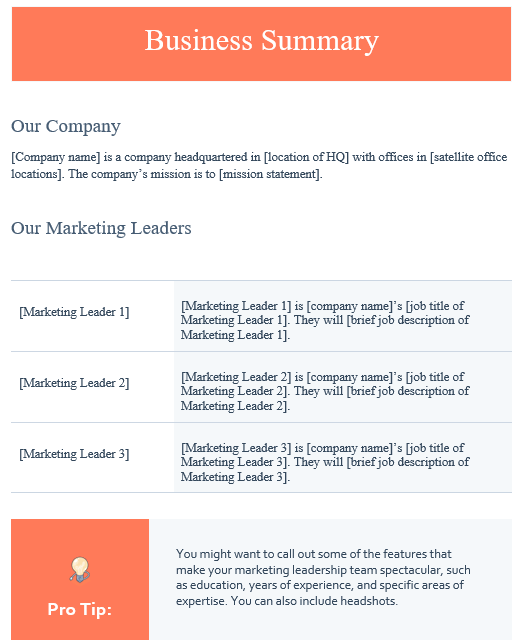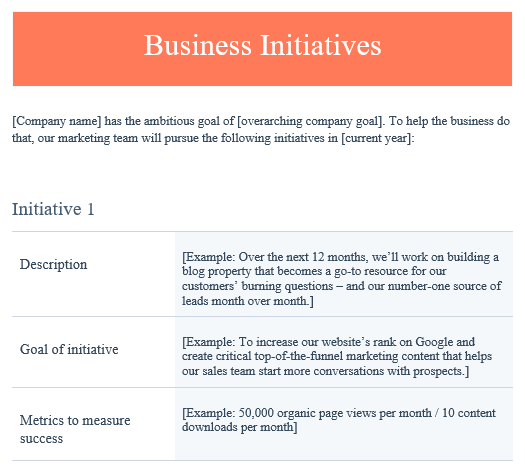Without an Effective Marketing Plan, things can get messy and if you don’t, it’s nearly impossible to budget a number for the projects, hiring, and outsourcing you’ll need to secure over the course of a year. Whether you are a startup looking to enter the market or a seasoned enterprise aiming for growth, a strategic marketing plan can make all the difference.
To make creating your plan even easier, we’ve put together a list of what to include in your plan and a few different plan templates where you can easily fill in the blanks.
Don’t Miss: Social Media Tips Is An Extensive Guide
In this article, we’ll discuss the key elements of an effective marketing plan, providing insight and actionable tips to help you successfully navigate the complex world of online marketing.
To begin, let’s dive into how to create a marketing plan and then take a look at what goes inside a high-level marketing plan.
Free Marketing Plan Template [Get Your Copy] Download Now
![5 Steps to Create an Outstanding Marketing Plan [Free Templates]](https://androidgoal.com/wp-content/uploads/2023/11/Outline-for-Marketing-Plan-and-Free.png)
Outline for Effective Marketing Plan
The marketing plan outline below will help you create an effective plan that easily gets buy-in from stakeholders and effectively manages your marketing efforts.
Marketing plans can be quite granular to reflect the industry you’re in, whether you’re Business to consumers (B2C) or other businesses (B2B), and how big your digital presence is.
1] Executive Business Summary

In a marketing plan, your business summary is exactly what it sounds like. It is essential to include this information so that all stakeholders, including your direct reports, get to know your company in detail before looking at the more strategic elements of your plan. Even if you’re presenting this plan to people who have been with the company for a while, it doesn’t hurt to get everyone on the same page.
An executive summary of an outstanding marketing plan should provide a high-level overview of the key elements of the plan. It should be concise but compelling, capturing the essence of your marketing strategy.
Most business summaries include:
- The company name
- Where it’s headquartered
- Its mission statement
2] Market Analysis
The market analysis section of an effective marketing plan is crucial for understanding the current state of the industry, identifying opportunities and threats, and gaining insight into your target audience.
3] SWOT Analysis

The business summary of your marketing plan also includes a SWOT analysis, which stands for the business’s strengths, weaknesses, opportunities, and threats. Incorporating this information is essential so that you can develop targeted strategies that help you capitalize on your strengths and improve your weaknesses.
A SWOT analysis for a marketing plan involves assessing the internal Strengths and Weaknesses of your organization and the external Opportunities and Threats in the market. Here’s how it might look for an outstanding marketing plan:
Strengths:
Brand Reputation:
A strong and positive brand image can be a significant strength.
Unique Selling Proposition (USP):
Clearly defined USPs give your product or service a competitive edge.
Talented Marketing Team:
Having a skilled and creative marketing team contributes to the plan’s success.
Innovative Products/Services:
Unique and innovative offerings can attract a wider audience.
Customer Loyalty:
A loyal customer base can be leveraged for word-of-mouth marketing.
Weaknesses:
Limited Budget:
Constraints on financial resources may limit the scope of marketing activities.
Ineffective Communication:
Poor internal or external communication can hinder marketing effectiveness.
Lack of Data Analysis:
The inability to analyze data may result in missed opportunities for improvement.
Limited Market Presence:
If the brand has low visibility in the market, it could be a weakness.
Slow Response to Trends:
The inability to adapt quickly to market trends may hinder competitiveness.
Opportunities:
Emerging Markets:
Identify and tap into new or growing markets.
Technological Advancements:
Leverage new technologies for marketing and communication.
Collaborations and Partnerships:
Explore partnerships that can expand reach and enhance offerings.
Changing Consumer Trends:
Adapt marketing strategies to align with evolving consumer preferences.
Global Expansion:
Consider opportunities for expanding into international markets.
Threats:
Competitive Landscape:
Intense competition may pose a threat to market share.
Economic Downturn:
Economic uncertainties can impact consumer spending and demand.
Regulatory Changes:
Changes in regulations may affect marketing strategies.
Technological Disruptions:
Rapid technological changes can make current strategies obsolete.
Negative Publicity:
Public relations crises can harm the brand’s reputation.
Analysis:
Capitalizing on Strengths:
Leverage brand reputation and USPs in marketing campaigns.
Empower the marketing team to maximize their creativity.
Addressing Weaknesses:
Explore cost-effective marketing channels given budget constraints.
Improve internal communication and invest in training.
Maximizing Opportunities:
Tailor marketing strategies to tap into emerging markets.
Embrace new technologies for more effective campaigns.
Mitigating Threats:
Keep a close eye on the competitive landscape and adjust strategies accordingly.
Stay informed about regulatory changes and adapt marketing plans as needed.
4] Business Initiatives

The business initiative component of a marketing plan helps you share your department’s various goals. Be careful not to include big-picture company initiatives, which you would normally find in a business plan.
This section of your marketing plan should outline specific projects to market. You will also describe the goals of those projects and how those goals will be measured.
Every initiative should follow a smart approach to creating goals. They should be specific, measurable, achievable, relevant, and time-bound.
5] Customer Analysis
In this part of the effective marketing plan outline, you will find plenty of space to share all the data you gathered during your market research. If your company has already done a thorough market research study, this section of your marketing plan may be easier to put together. Either way, try to do your research before synthesizing it into a document worth sharing.
A buyer persona is a semi-fictional description of your ideal customer, focusing on traits like:
- Age
- Location
- Title
- Goals
- Personal challenges
- Pains
- Triggering event
6] Competitor Analysis

Including a competitive analysis is essential when developing a marketing plan. Your buyer personas have choices when it comes to solving their problems, both the types of solutions they consider and the providers who can manage those solutions.
In your market research, you should consider your competition, what they do well, and where you can potentially fill gaps.
Here’s a guide on how to conduct a comprehensive competitor analysis:
- Positioning
- Market share
- Offerings
- Pricing
7] Marketing Strategies
1. Product:
- Product Differentiation: Clearly define what makes your product unique and communicate this effectively. Emphasize features, quality, or innovations that set your product apart from competitors.
- Product Lifecycle Management: Develop strategies that align with where your product is in its lifecycle. This might involve introducing new features, rebranding, or exploring new markets.
- Customer Feedback: Continuously gather and analyze customer feedback to make improvements and adjustments to your product offerings.
2. Price:
- Value-Based Pricing: Set prices based on the perceived value to the customer rather than just production costs. Highlight the value your product brings and justify the pricing.
- Pricing Strategies: Explore various pricing strategies such as penetration pricing, skimming, or bundling, depending on your market positioning and business objectives.
- Competitor Analysis: Regularly assess competitor pricing to ensure your prices remain competitive. Consider occasional promotions or discounts strategically.
3. Promotion:
- Integrated Marketing Communications (IMC): Ensure a consistent message across all promotional channels—online and offline. This includes advertising, public relations, social media, and content marketing.
- Content Marketing: Develop valuable, relevant content that establishes your brand as an authority in your industry. This can include blog posts, videos, infographics, and more.
- Influencer Marketing: Leverage influencers in your industry to reach a wider audience and build credibility.
4. People:
- Customer Relationship Management (CRM): Implement CRM systems to better understand and engage with your customers. Personalize interactions based on customer preferences and behavior.
- Employee Training: Train and empower your employees to deliver exceptional customer service. Happy and knowledgeable staff can positively impact the customer experience.
- Internal Branding: Ensure that your employees are aligned with the brand values and messaging. They are ambassadors for your brand and can significantly influence how your brand is perceived.
8] Tactics and Action Plan
Break down each strategy into actionable steps.
Define responsibilities, timelines, and budgets.
9] Budget
Allocate a budget for each marketing initiative.
Include costs for advertising, promotions, events, and any other relevant expenses.
Don’t confuse the marketing budget elements of your plan with your product pricing or other company finances. Your budget describes how much money the business has allocated to the marketing team to pursue the initiatives and goals outlined in the elements above.
Example marketing expenses include:
- Outsourcing costs to a marketing agency and/or other providers
- Marketing software
- Paid promotions
- Events (those you’ll host and/or attend)
10] Marketing Technology
Last, but certainly not least, your marketing plan should include an overview of tools to include in your marketing technology (MarTech) stack. This is the tool that will help you achieve the goals described in the previous section.
Identify the necessary tools and technologies for implementation. This could include CRM systems, analytics tools, or marketing automation platforms.
Here are some categories of technology and tools commonly used in marketing plans:
Customer Relationship Management (CRM) Software:
Examples: Salesforce, HubSpot, Zoho CRM
CRM tools help manage customer interactions, track leads and streamline sales processes.
Marketing Automation Platforms:
Examples: Marketo, HubSpot, Pardot
Automate repetitive marketing tasks, such as email campaigns, lead nurturing, and social media posting.
Analytics and Data Visualization Tools:
Examples: Google Analytics, Adobe Analytics, Tableau
Analyze website traffic, user behavior, and campaign performance. Visualize data to make informed decisions.
Social Media Management Tools:
Examples: Hootsuite, Buffer, Sprout Social
Schedule posts, track social media engagement, and manage multiple social media accounts from one platform.
Content Management Systems (CMS):
Examples: WordPress, Drupal, Joomla
Manage and publish digital content, including blogs, articles, and multimedia.
Conclusion
In conclusion, a well-crafted and executed marketing plan is the cornerstone of success for any business endeavor. An effective marketing plan goes beyond traditional advertising and promotion; it serves as a strategic roadmap, guiding the organization toward its goals and ensuring that every marketing effort contributes to the overall mission.
The significance of a robust marketing plan lies in its ability to align the organization with market trends, consumer needs, and competitive landscapes. Through thorough market research and analysis, businesses can identify opportunities for growth, potential challenges, and areas for differentiation. This insight forms the foundation upon which a successful marketing strategy is built.
Furthermore, an effective marketing plan acts as a dynamic tool, adapting to changes in the business environment, consumer behavior, and technological advancements. It provides a framework for measuring the success of marketing initiatives, enabling businesses to track key performance indicators, assess return on investment, and refine their approach for continuous improvement.
![5 Steps to Create an Outstanding Marketing Plan [Free Templates]](https://androidgoal.com/wp-content/uploads/2023/11/effective-marketing-plan-1.jpg)
1 thought on “Create an Effective Marketing Plan (Free Sample Templates)”